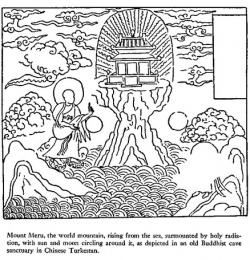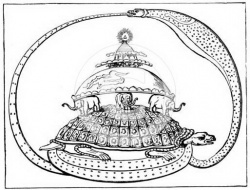Difference between revisions of "Indian Buddhist cosmology"
(Blanked the page) |
|||
| Line 1: | Line 1: | ||
| + | [[File:Meru-47.JPG|thumb|250px|]] | ||
| + | by Shuichi Yamamoto and Victor S. Kuwahara | ||
| + | The most interesting aspects of self-consistent ancient Indian [[Buddhist cosmology]] are the conceptualizations of vast space, incomprehensible time and the considerations of life existence. [[Buddhist cosmology]] is well expressed in a category of Buddhist scriptures that explains all worldly phenomena called the Abhidharmakoßa-bhásya by [[Vasubandhu]] (Seshin) in 5 A.D. The vast cosmology is described allegorically where Mt. [[Sumeru]] (Shumisen) is located at the center amongst a ring of seven mountains ranges and dividing seas. There are also four continents sur- rounding the rings of mountain ranges and seas. Human beings live on one of the four continents shaped in the form of a trapezoid called the Embudai (Senbushu). The world of the Hell exists vertically under the Embudai continent, while Heaven (Ten) and Meditator (Zenjo-sha) exists vertically above it. The sun and moon rotate around the entire one-world system. | ||
| + | The allegoric concept of the one-world system in Buddhism with Mt. [[Sumeru]] at its center extends 13 million Yojana (Yujun) or 90 million km, which is comparable to the distance between the Earth and Sun. This is in exact accordance with our solar system both in name and reality. Fur- ther, 1000 one-world systems are called a small-thousand-world system, 1000 small-thousand-world systems are called a medium-thousand- world-system, and 1000 medium-thousand-world systems are called a large-thousand-world system. This system is called a three-thousand- world system which equates to 1 billion one-world systems! The galaxy including our solar system has about 200 billion fixed stars. There may be several hundred million planet systems in the galaxy. In this sense, the galaxy corresponds to the medium-thousand-world system in Bud- | ||
| + | dhism and the large-thousand-world system may correspond to the whole universe. There is no other ancient cosmology that grasps the vastness of the universe like Buddhism at a time when scientific knowl- edge was non-existent. When considering other ancient cosmology, i.e. ancient Babylonia, Egypt, Greece, and China, we find that these cultures were only able to grasp a limited one world centered on the planet Earth. In comparison, [[Buddhist cosmology]] is astronomically robust. | ||
| + | There are other concepts of worlds and universes in Buddhism. For example, allegorically Aksobhya-buddha (Ashuku-butsu) lives in the Abhirata-buddha land (Myoki-koku) located one thousand Buddha lands to the east of the planet Earth, Amitabha-buddha (Amida-butsu) lives in the Sukhavati land (Gokuraku-jodo) 10 trillion Buddha lands to the west while Bhaisajya-[[Guru]] (Yakushi-nyorai) lives in the VaidËryanirbhåsa land (Joruri-sekai) over ten Ganga-nadi-valuka (Gogasha) Buddha lands to the east. Here the distance of Ganga-nadi-valuka Buddha lands is 1052 which is equivalent to the number of sand granules in the Ganges River. Current cosmology suggests there are 200 billion galaxies each of which includes the 200 billion fixed stars. Therefore, there are 4×1022 fixed stars. In short, the universal view of the Buddha land suggested in Bud- dhism grasps a far larger world than those prescribed by modern sci- ence. One concept in present cosmology is the idea of a multi-dimen- sional cosmology which includes many universes. Thus, Buddhist cos- mology can be said to be most similar to or resemble the multi-dimen- sional cosmology. | ||
| + | Buddhism also discusses the concept of the time continuum using the four kalpa periods, i.e., jo-ko, ju-ko, e-ko and kuu-ko which are the four steps from construction to destruction of a star, galaxy and universe. Individually, they are; jo-ko: a period of creation, ju-ko: a period of con- tinuity at a stable state, e-ko: a period of destruction, and kuu-ko: a peri- od of transition in a state of emptiness. Each period is 20 kalpas. The term kalpas literally means a very long time in Buddhism, but in Hin- duism it means 4.32 billion years. From this context, each step or period is about 80 billion years equating to a full cycle at 320 billion years, which is an extremely long time. These four periods are one cycle and continues eternally; the history from creation to extinction drawn in Buddhism. Therefore, the period from creation to extinction of the uni- verse in Buddhism is about 13.7 billion years in accordance with mod- ern cosmology. | ||
| + | Here it is important to note some interesting points about the relation- ship between life and the four kalpa periods. During the pre- jo-ko stage a faint wind begins to blow creating a one-world system with Mt. | ||
| + | [[File:1155819.jpg|thumb|250px|]] | ||
| + | [[Sumeru]] at the center. The faint wind is generated from the [[Karma]] of sen- tient beings. Once the one-world system is created the [[Sentient beings]] are reborn, returning and descending, for example, from heaven or the kuu-ko stage. When all [[Sentient beings]] are reborn from the e-ko stage via the kuu-ko stage, the jo-ko is completed. In Buddhism, the expres- sion of the faint wind is the force of increasing [[Karma]], the common [[Karma]] of [[Sentient beings]] which creates their own environment, such as a planet, a star, a galaxy and the universe. Furthermore, the living entity is constructed by [[THE FIVE AGGREGATES]] (i.e., body, mind and their behaviors of sentient being) from individual [[Karma]]. In the Buddhism, the body and mind of life is temporarily harmonized. | ||
| + | {{R}} | ||
| + | [[Category:Buddhist Cosmology]] | ||
Revision as of 04:47, 6 February 2013
by Shuichi Yamamoto and Victor S. Kuwahara The most interesting aspects of self-consistent ancient Indian Buddhist cosmology are the conceptualizations of vast space, incomprehensible time and the considerations of life existence. Buddhist cosmology is well expressed in a category of Buddhist scriptures that explains all worldly phenomena called the Abhidharmakoßa-bhásya by Vasubandhu (Seshin) in 5 A.D. The vast cosmology is described allegorically where Mt. Sumeru (Shumisen) is located at the center amongst a ring of seven mountains ranges and dividing seas. There are also four continents sur- rounding the rings of mountain ranges and seas. Human beings live on one of the four continents shaped in the form of a trapezoid called the Embudai (Senbushu). The world of the Hell exists vertically under the Embudai continent, while Heaven (Ten) and Meditator (Zenjo-sha) exists vertically above it. The sun and moon rotate around the entire one-world system. The allegoric concept of the one-world system in Buddhism with Mt. Sumeru at its center extends 13 million Yojana (Yujun) or 90 million km, which is comparable to the distance between the Earth and Sun. This is in exact accordance with our solar system both in name and reality. Fur- ther, 1000 one-world systems are called a small-thousand-world system, 1000 small-thousand-world systems are called a medium-thousand- world-system, and 1000 medium-thousand-world systems are called a large-thousand-world system. This system is called a three-thousand- world system which equates to 1 billion one-world systems! The galaxy including our solar system has about 200 billion fixed stars. There may be several hundred million planet systems in the galaxy. In this sense, the galaxy corresponds to the medium-thousand-world system in Bud-
dhism and the large-thousand-world system may correspond to the whole universe. There is no other ancient cosmology that grasps the vastness of the universe like Buddhism at a time when scientific knowl- edge was non-existent. When considering other ancient cosmology, i.e. ancient Babylonia, Egypt, Greece, and China, we find that these cultures were only able to grasp a limited one world centered on the planet Earth. In comparison, Buddhist cosmology is astronomically robust. There are other concepts of worlds and universes in Buddhism. For example, allegorically Aksobhya-buddha (Ashuku-butsu) lives in the Abhirata-buddha land (Myoki-koku) located one thousand Buddha lands to the east of the planet Earth, Amitabha-buddha (Amida-butsu) lives in the Sukhavati land (Gokuraku-jodo) 10 trillion Buddha lands to the west while Bhaisajya-Guru (Yakushi-nyorai) lives in the VaidËryanirbhåsa land (Joruri-sekai) over ten Ganga-nadi-valuka (Gogasha) Buddha lands to the east. Here the distance of Ganga-nadi-valuka Buddha lands is 1052 which is equivalent to the number of sand granules in the Ganges River. Current cosmology suggests there are 200 billion galaxies each of which includes the 200 billion fixed stars. Therefore, there are 4×1022 fixed stars. In short, the universal view of the Buddha land suggested in Bud- dhism grasps a far larger world than those prescribed by modern sci- ence. One concept in present cosmology is the idea of a multi-dimen- sional cosmology which includes many universes. Thus, Buddhist cos- mology can be said to be most similar to or resemble the multi-dimen- sional cosmology. Buddhism also discusses the concept of the time continuum using the four kalpa periods, i.e., jo-ko, ju-ko, e-ko and kuu-ko which are the four steps from construction to destruction of a star, galaxy and universe. Individually, they are; jo-ko: a period of creation, ju-ko: a period of con- tinuity at a stable state, e-ko: a period of destruction, and kuu-ko: a peri- od of transition in a state of emptiness. Each period is 20 kalpas. The term kalpas literally means a very long time in Buddhism, but in Hin- duism it means 4.32 billion years. From this context, each step or period is about 80 billion years equating to a full cycle at 320 billion years, which is an extremely long time. These four periods are one cycle and continues eternally; the history from creation to extinction drawn in Buddhism. Therefore, the period from creation to extinction of the uni- verse in Buddhism is about 13.7 billion years in accordance with mod- ern cosmology. Here it is important to note some interesting points about the relation- ship between life and the four kalpa periods. During the pre- jo-ko stage a faint wind begins to blow creating a one-world system with Mt.
Sumeru at the center. The faint wind is generated from the Karma of sen- tient beings. Once the one-world system is created the Sentient beings are reborn, returning and descending, for example, from heaven or the kuu-ko stage. When all Sentient beings are reborn from the e-ko stage via the kuu-ko stage, the jo-ko is completed. In Buddhism, the expres- sion of the faint wind is the force of increasing Karma, the common Karma of Sentient beings which creates their own environment, such as a planet, a star, a galaxy and the universe. Furthermore, the living entity is constructed by THE FIVE AGGREGATES (i.e., body, mind and their behaviors of sentient being) from individual Karma. In the Buddhism, the body and mind of life is temporarily harmonized.

